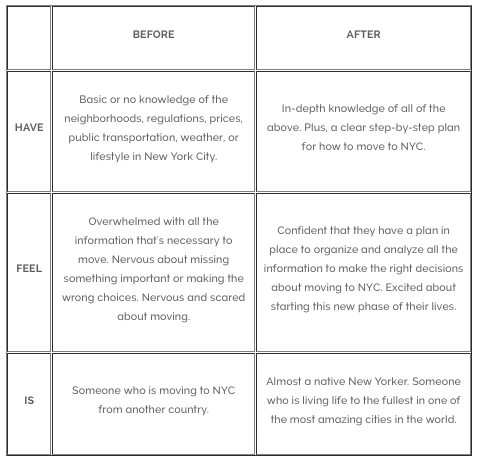When creating an online course, details matter. Sure, the course content will always be king, but the smaller aspects of creating an online business, like coming up with a name that sells, are so important.
In this guide, we’ll explain the three steps necessary for naming an online course. To illustrate the process of how to name an online course, we’ll use this topic as an example from an example creator:
“I have lived in four different cities in the last three years. Moving to a new city is always hard, but it gets easier once you’ve done it several times. So, I want to teach people ‘How to Move to a New City.’”
Note: These steps assume creators already know the topic of their online course and have validated its demand (i.e. they know what content to cover). If you’re a creator who hasn’t decided on a topic yet, we recommend checking out this post on how to find your niche.
Step 1: Find an audience
The most common mistake creators make when starting an online business is that they don’t have a clear idea of who their potential customers are. When creators know exactly who their target audience is, it’s easier to:
- Identify customer pain points
- Figure out where to find customers
- Use the right language to attract them
Always cast wide…
Begin by describing the audience using very general demographic information. Consider questions like:
- Is the audience mostly located in a specific country?
- What language does the audience speak?
- Are they mostly male, female, or evenly represented?
- What’s their level of education?
- What age-range are most of them in?
For our example creator’s course on “How to Move to a New City,” he came up with the following demographic description:
- I’ll target people in the United States, because I only have experience moving to cities inside the US.
- My audience will be mostly foreigners who are coming to the US for work or school. So, I can assume they speak English—in most cases as a second language.
- I’ll assume my audience is pretty evenly distributed between male and female.
- I plan to target mostly people who at least have or are in pursuit of an undergraduate degree.
- My target audience is probably in the 18–35 age range.
The points above describe our creator’s audience in very broad strokes and that’s OK, he will narrow it down moving forward.
But narrow it down…
Once you as a creator have a general idea of who to target, you’ll start to notice there are several clearly defined groups with similar characteristics within what you just described. Make a list of who these people are and pick who would benefit the most from your course.
For our example course, our creator can identify these sub-segments:
- Undergraduate students who are coming to the US to finish their studies or to study abroad for a year
- People with undergraduate degrees who want to pursue a graduate-level degree in the United States
- People who are coming to the US for work or business
Yes, there are more groups, but he thinks those are the ones he can best serve with his online course. Ultimately, he has decided to go with the last group because it’s the one he can relate to the most and who he thinks is most likely to pay for the course. He also chose NYC as the destination city because he thinks it’s a location that attracts a lot of people who match this segment.
His target demographic becomes narrower to:
- People moving to NYC instead of anywhere in the US
- People moving to the US for work or business on the higher end of the age range identified
Consider psychographics as more than a fancy word
Finally, we’ll get into the specifics of how this group of people behaves and why—that’s what psychographics are.
Try to answer these questions about your own target audience:
- What are their goals?
- What are they interested in?
- What do they fear?
- What are their challenges?
- What do they believe in?
- From which culture are they?
It’s easy to make the mistake of answering these questions within the boundaries of the topic of your course. Instead, creators should try to find deeper, more general answers that relate to them as individuals.
The segment our creator chose is people who are moving to a US city for work or business. He was a part of this group only a couple of years ago, so he can relate to what they are going through.
He identified that people who are moving to a new city or country:
- Want to be successful in this new environment
- Are interested in and are excited about the local culture but also want to find places that are similar to home somehow
- Can feel overwhelmed by everything that needs to be done to move
- Don’t know many people in this new city
- Probably come from a different culture and have different traditions
Put the puzzle pieces together
Now that you’ve gone three levels deep into identifying a target audience for your course, it’s time to summarize your work. You don’t need to write every descriptor you came up with, but describing the audience in a few sentences is beneficial.
Here’s what our creator came up with for his course:
Young adults who are moving to the United States—particularly New York City—from another country because of a new job. They are excited but also stressed out about changing their entire lives by moving to a new city.
Step 2: Craft a transformation
At Teachable, we believe transformations are a great way to communicate the value of an online course.
Here’s an example to drive it home. Which one of these phrases do you find more inspiring and attractive?
- Learn woodwork
- Turn old wooden furniture into beautiful and functional pieces of art
The first might be great phrasing for a woodwork-tool operations manual, but may not get many customers as an online course. The second one, on the other hand, takes the reader on a journey with a clearly defined beginning and end—a transformation.
Remember why people take courses in the first place: They want to change something about their lives. By the end of your course, your students will know something they didn’t before. Consider the matrix below:

{{minicourse-component="/blog-shortcodes/blog-popup"}}
To fill in this matrix, you should answer these questions:
- What does a prospective student have before taking your course? What will they have after they finish it?
- How does a prospective student feel before taking your course? How will they feel after they finish it?
- Who are they before taking your course? Who will they be after finishing it?
Our example creator’s matrix may look like this:

Remember: A truly powerful transformation will also communicate who your customers will “be” after taking your course.
Step 3: Put pen to paper
There are three rules to writing a great course name:
- It should be benefit-driven.
- It should be specific.
- It should convey emotion.
What’s in a name
Let’s start with the most important one: Your course name should be benefit-driven. This is where your transformations come into play.
Our creator has named his example course: “Moving to New York City: A Guide to Becoming a Local in the Big Apple.”
The first half of the title clearly communicates what this course is about, while the second half introduces the emotional element of my transformation. It’s important that you as a creator keep your course name relatively short so it’s easy to remember, as you can always add more detail with a subheading or course description. The name of your course can help get people into your marketing funnel.
Here’s our creator’s descriptive subhead:
Get all the information you need to make smart decisions about your move—from navigating the subway like a true New Yorker to negotiating with landlords—and a detailed plan to get it all done.
Sprinkle in the details
Our second rule of writing a strong course name is focusing on being specific.
This can come in the form of adding a quantifiable element to your course’s benefit. Consider:
- Can you quantify the outcome of your transformation? How many times better is the outcome than the initial state?
- How long will it take the student to achieve the transformation? How much time are you saving them?
- How many steps will it take a student to complete the transformation?
Notice how none of the bullet points above mention anything about the length of your course. Avoid including claims like “12 hours of content” or “45 lessons,” which don’t relate directly to the transformation or benefit of your course.
Back to our example creator, he knows that his course must teach his students everything they need in a very short period of time. Hence his name has become: “Moving to New York City: A Guide to Becoming a Local in the Big Apple (in ONE Week)”
Let those emotions flow
Emotion is one tool every creator should evoke. Include power words in your course name, as they can be used to trigger emotion, excitement, or curiosity.
Consider the following:
- Power words to elicit curiosity: secret, surprising, inspiring, unexpected, shocking.
- Power words to evoke speed: hack, tricks, tips, kickstart.
- Power words to communicate comprehensiveness: complete, ultimate, comprehensive, detailed, entire.
You can find an entire list of power words in this great post on the Sumo blog.
To drive the point home, let’s take a look at our example creator’s course one last time. He’s already used specificity to evoke speed, so now he’ll use a power word to communicate comprehensiveness, implying his course is the only resource for people looking to move to NYC.
His final result is: “Moving to New York City: The Ultimate Guide to Becoming a Local in the Big Apple (in ONE Week)”
Portions of this article were repurposed from a previous post from Eduardo Yi.
Join more than 150,000 creators who use Teachable to make a real impact and earn a real income.



.png)

.png)
.png)


